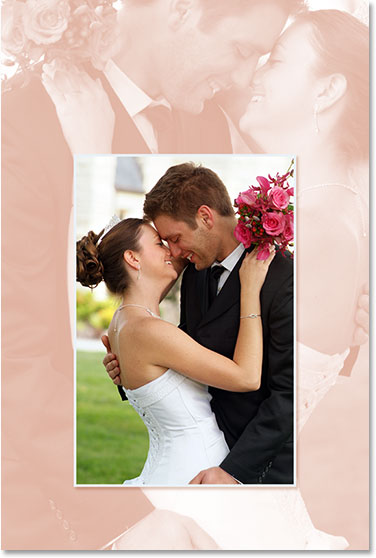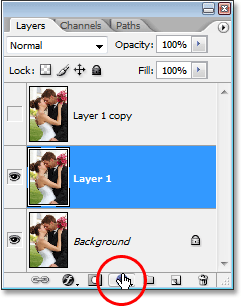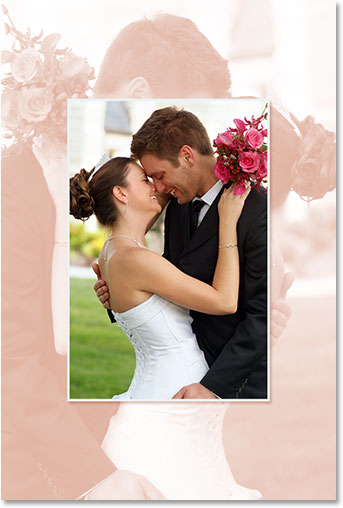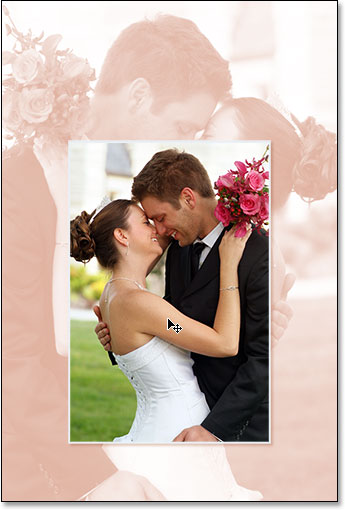In this Photoshop Effects tutorial,
we're going to learn how to use a photo as its own background, which is
a great effect to use with wedding photography but can also be used
with any image. We're going to be creating two copies of our photo,
using one as our main image and the other as the background, which we'll
be colorizing, flipping and fading into more of a watermark-style
image.
We'll then take our main photo, reduce it in size, give it a nice
border and shadow effect, and finally, move it into the perfect spot in
front of the background. We'll even be sampling some colors from the
image to make sure everything blends in nicely. This is an easy photo
effect to create and takes very little time from start to finish.
Before we begin... This version of the tutorial is for Photoshop CS5
and earlier. If you're using Photoshop CC or CS6, you'll want to follow
along with the fully updated version.
Here's the image I'll be starting with:

The original image.
And here's the final effect we're going for:

The final result.
Step 1: Duplicate The Background Layer Twice
The first thing we need to do for this photo effect is create a
couple of copies of our image. We can see in the Layers palette that we
currently have just one layer, the Background layer, which contains our
photo:

Photoshop's Layers palette showing the original image on the Background layer.
Let's make a couple of copies of it, and for that, we'll use the handy keyboard shortcut Ctrl+J (Win) / Command+J
(Mac). Use the keyboard shortcut once to create the first copy, then
use it again to create a second copy. You should now have three layers
in your Layers palette:

Press "Ctrl+J" (Win) / "Command+J" (Mac) twice to create two copies of the Background layer.
The main reason why we've created two copies here is to avoid working
on our original Background layer, since it contains our photo's
original pixel information and we always want to keep that safe in case
we need to go back to it.
Step 2: Hide The Top Layer
The layer at the top of the Layers palette is going to become our
main page, but we're going to work on the layer below it for now, which
is going to become our background. In order to see what we're doing
though, we need to hide the top layer. To do that, click on its layer visibility icon (the icon that looks like an eyeball) on the left of the layer in the Layers palette:
Hide the top layer in the Layers palette by clicking on its layer visibility (eyeball) icon.
Nothing will appear to have happened to your image when you hide the
top layer, since all three layers contain the exact same image, but
we'll now be able to see what we're doing when we turn the layer below
it into our background, which we'll do next.
Step 3: Sample A Color From The Image To Use For The Background
Let's create our background. First, click on the middle layer in the Layers palette to select it:

Click on the middle layer in Photoshop's Layers palette to select it.
We need to sample a color from the image which we're going to use to colorize the background. To do that, grab the Eyedropper Tool from the Tools palette, or press I on your keyboard to quickly select it:

Select the Eyedropper Tool.
Then, with the Eyedropper Tool selected, click on an area inside your
image which contains the color you want to use for your background. I'm
going to sample a color from the woman's cheek, which should work
nicely:

Click inside the image with the Eyedropper Tool to sample a color.
You'll see the color appear as your Foreground color in the Tools palette:

The sampled color now appears in the Foreground color swatch in the Tools palette.
Step 4: Colorize The Background Using A Hue/Saturation Adjustment Layer
Now that we have our sampled color, let's use it to colorize the background. Click on the New Adjustment Layer icon at the bottom of the Layers palette:

Click on the "New Adjustment Layer" icon.
Then select Hue/Saturation from the list:

Select "Hue/Saturation" from the list of Adjustment Layers.
This brings up Photoshop's "Hue/Saturation" dialog box. There's no
need to fumble around with any sliders here trying to pick a color
because we've already chosen the color we want to use, so all we need to
do is select the Colorize option in the bottom right corner of the dialog box:

Click inside the checkbox to the left of the "Colorize" option to select it.
As soon as you select that option, Photoshop goes ahead and colorizes the image using the sampled color:

The image now colorized using the color sampled from it.
I'm going to boost the saturation of the color by dragging the Saturation slider to the right until the saturation value is at 50. Then, to give the background a washed-out appearance, I'm going to drag the Lightness slider to the right to a value of around 75:

Increase the "Saturation" to 50 and the "Lightness" to 75.
Click OK when you're done to exit out of the dialog box. Here's my image after being colorized and lightened:

The background is now colorized and appears washed out.
Step 5: Flip The Image Horizontally
There's one last thing to do with our background. Let's flip it
horizontally so it appears as a mirror image of our main photo. To do
that, we first need to select the correct layer. At the moment, we have
the Hue/Saturation adjustment layer selected in the Layers palette, so
click on "Layer 1" below it which contains our background image. Then go
up to the Edit menu at the top of the screen, choose Transform, and then choose Flip Horizontal. The photo will flip sideways, giving us our "mirror image" and completing our work on the background:

Go to Edit > Transform > Flip Horizontal to flip the background sideways, creating a mirror image of the main photo.
Step 6: Turn The Top Layer Back On
We're done with our background, so let's work on our main image,
which is on the top layer in the Layers palette. The layer is currently
hidden, so click once again on its layer visibility icon to turn it back on:

Click once again on the layer visibility icon of the top layer to turn it back on.
When you click on the icon, the eyeball will re-appear and the
original image will appear in the document, temporarily blocking the
background we just worked on from view.
Step 7: Resize The Main Image With Free Transform
We're going to make our main image smaller, and we'll do that using Photoshop's Free Transform command. First, click on the top layer in the Layers palette to select it. Then use the keyboard shortcut Ctrl+T (Win) / Command+T (Mac) to bring up the Free Transform handles around the image. Hold down Shift+Alt (Win) / Shift+Option
(Mac) and drag any of the corner handles inward to reduce the size of
the photo. Holding Shift constrains the proportions of the image as you
drag, and holding Alt/Option tells Photoshop to resize the image from
its center. It's a judgment call on your part how small you want to make
your image. I'm going to make mine roughly 60% of its original size:

Reduce the size of the original image using "Free Transform".
Press Enter (Win) / Return (Mac) when you're happy with the new size of your image to accept the transformation.
Step 8: Add A Stroke To The Main Image
Let's add a thin border around our main image. We'll use a Stroke Layer Style for that. Click on the Layer Styles icon at the bottom of the Layers palette:
Click on the "Layer Styles" icon at the bottom of the Layers palette.
Then select Stroke from the bottom of the list of Layer Styles:

Select "Stroke" from the list.
This brings up Photoshop's Layer Style dialog box
set to the Stroke options in the middle column. Let's choose a color for
our stroke, again by sampling a color from the image. To do that, click
on the color swatch, which by default appears red:

Click on the color swatch for the Stroke to select a new color.
When you click on the color swatch, Photoshop's "Color Picker" will
appear, which is normally where you would choose a new color, but we're
going to ignore it since we want to sample a color directly from the
image itself. To do that, move your mouse over the main image and you'll
see your mouse cursor change into the Eyedropper icon. Then, just as we
did before, click on an area inside the image to sample the color. I'm
going to sample a shade of white from the bride's dress:

Sample a color from inside the image to use with the Stroke.
When you click inside the image, you'll see the Stroke's color swatch
change to the color you just sampled. When you're happy with the color
you've chosen, click OK in the top right corner of the Color Picker to
close out of it (even though we never actually used it).
Once you have your stroke color chosen, go up to the Stroke Size option at the top of the dialog box and set it to about 4px.
You may want to set it a bit higher if you're using a large, high
resolution image, but we're not going for a polaroid look here. We want
something a little more elegant, especially if you're doing this with a
wedding photo, so try to keep your stroke fairly thin. Also, set the Position option to Inside:

Keep the Stroke fairly thin by setting its "Size" to about 4 pixels, and change the "Position" to "Inside".
Don't click OK just yet. We have one more Layer Style to add.
Step 9: Add A Drop Shadow
Let's add a Drop Shadow before closing out of the Layer Style dialog box. Click directly on the words Drop Shadow on the left of the dialog box:

Click directly on the words "Drop Shadow" on the left.
This will bring up the Drop Shadow options in the middle column,
where the Stroke options were a moment ago. By default, Photoshop sets
the Drop Shadow color to black, but that's too harsh for this effect, so
let's choose a different color. Just as we did with the Stroke, click
on the color swatch:

Click on the Drop Shadow's color swatch in the Layer Style dialog box.
This will again bring up Photoshop's Color Picker, and again I'm
going to ignore it because I want to sample a color directly from the
image. I want my Drop Shadow to be roughly the same color as what I used
to colorize my background, but just a little darker (since it's a
shadow, after all), so I'm going to sample a color from the man's face,
which is slightly darker than the woman's:

Sample a slightly darker color from what you used to colorize the background for the Drop Shadow.
As you click inside the image, the Drop Shadow color will change to
whichever color you just clicked on, so you can see a preview of your
shadow color as you're clicking. When you're happy with the color, click
OK in the Color Picker to exit out of it. Your color swatch in the
Layer Style dialog box will now have changed to the color you sampled.
With my color chosen, I'm going to lower the Opacity of my Drop Shadow to about 40% so it's not too intense, and I'm going to change my Angle to about 130°:

Lower the opacity of the shadow to around 40% and change the angle to roughly 130°.
Click OK when you're done to exit out of the Layer Style dialog box. Your image should now look something like this:

The image after applying the Stroke and Drop Shadow.
Step 10: Reposition The Main Image As Needed
Things are looking good, except for one thing. My main image in front
is blocking the man and woman's face in the background, so the first
thing I'm going to do is move the main image. To move it, we need the Move Tool, so either select it from the Tools palette or press V on your keyboard:

Select the Move Tool.
Then, with the top layer still selected, click inside the document
and drag the main image into its new location. I'm simply going to drag
mine down a little, so to make sure I'm dragging in a straight line, I'm
going to hold down my Shift key as I click and drag:

Drag the main image to a new position with the Move Tool. Hold "Shift" to drag in a straight line.
Step 11: Resize And Reposition The Background Image As Needed
Since the couple's faces in the background are still being blocked by
the top portion of my main image, I'm going to finish things off by
increasing the size of my background image. Normally you wouldn't want
to increase the size of an image because it tends to make images look
soft and dull, but since this image is being used simply as a
background, we can get away with it. Before I can make the background
larger though, I first need to select its layer, so I'm going to click
on "Layer 1" in the Layers palette to select it.
If you're currently working with your image in a document window, you're doing to want to press the F key on your keyboard at this point to switch Photoshop to Full Screen Mode With Menu Bar,
otherwise you won't be able to see what you're doing with the Free
Transform handles. Then just as we did before, I'm going to use the
keyboard shortcut Ctrl+T (Win) / Command+T (Mac) to bring up the Free Transform handles, this time around the background image. I'm going to hold down my Shift key to constrain my image porportions, as well as Alt (Win) / Option
(Mac) to resize the image from its center, and I'm going to click on
any of the corner handles and drag it outward to enlarge my background
image:

Enlarging the background with Free Transform.
I'm also going to reposition my background slightly by simply
clicking anywhere inside of it with the Free Transform handles still
active and dragging it into its new position. I'm going to move mine up a
little and a little to the right until my background seems to be
balanced nicely with the main image.
When you're happy with the size and location of your background image, press Enter (Win) / Return
(Mac) to accept the change and you're done! Here, after making my
background a bit larger and moving it slightly so it balances better
with the main image, is my completed effect:

The final effect.
No comments:
Post a Comment